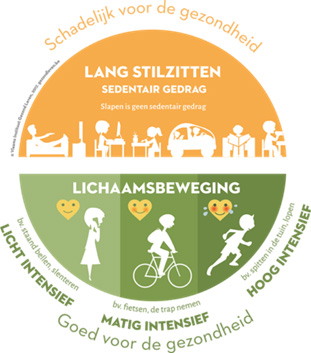Sit less
Sitting or lying still for a long time and using so little energy is also called sedentary behavior.

On average, an adult spends more than eight hours a day sitting: in the car or train, at school or at work, on the couch to watch TV or read a book, at the computer or at the table. Sleeping is not part of this.
Sitting still for long periods of time can lead to health risks. You cannot compensate or eliminate these risks by half an hour of moderately intensive exercise during the day, unless you exercise at least one hour every day at moderate intensity.
A healthy day consists of a mix of:
- sitting;
- movement with light intensity (e.g. standing on the phone, doing the dishes or cooking, walking slowly);
- moderate-intensity exercise (e.g. cycling to work, washing the windows, taking the stairs);
- high-intensity exercise (e.g. brisk cycling, jogging, digging).
Preferably, you break sitting every twenty minutes to half an hour. And that is easy.
Health risks
Your muscles work much less when you sit. Your heart also beats slower. As a result, your metabolism does not run as it should and your fat breakdown is inhibited.
Sitting still for a long time can lead to a lot of physical and mental risks.
If you stand up every half hour and move for a while, you put your muscles in motion again. Your blood circulation improves and your concentration increases.
How to sit less and move more?
You don't have to be an athlete or exercise intensively to get enough exercise.
Change little by little: stand up from your desk or chair every now and then and walk around. Every progress counts!
- Create a healthy mix
Stand, sit and move in your daily life. Alternate between light, moderate, or high-intensity activities (see exercise triangle ).
- Change unhealthy habits gradually
Stand up more often at work, for example to fetch water. Park your car a little further and then go on foot. Do stretching exercises during the commercial breaks on TV. Take a standing coffee break.
- Let yourself be tempted to undertake an intensive activity every week
- Keep yourself motivated
For example, give yourself a healthy reward such as your favorite drink or a terrace with friends. Remind yourself of your reward with a post-it in your calendar.
- Move with pleasure
Choose activities that you enjoy. If you don't like to walk alone, find a group to walk together.
- Adjust your environment to make it easier for you to stand up
Place a standing table near your desk so that you can alternate between standing and sitting to work. Or put the TV remote a little further away so you have to stand up to get it.
- Make your plans as specific as possible
What are you going to do? Where, when and with whom? Eg. on Saturday and Sunday evenings I watch TV with my love for 10 minutes less and instead we go to the park around the corner.
- Do not exercise exclusively in your free time
View the tips below to exercise more at work, at home, on the road, on vacation or in your free time.


